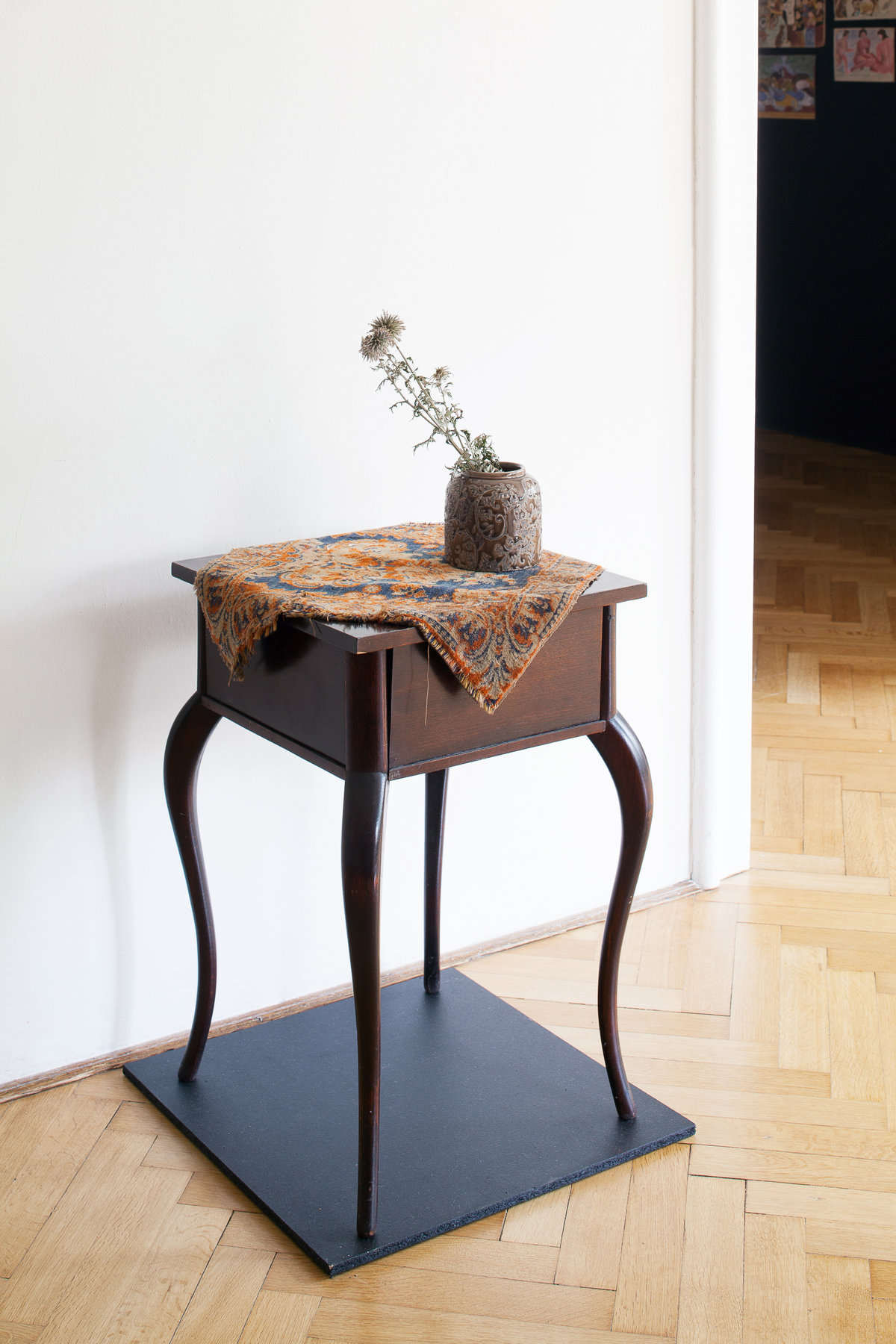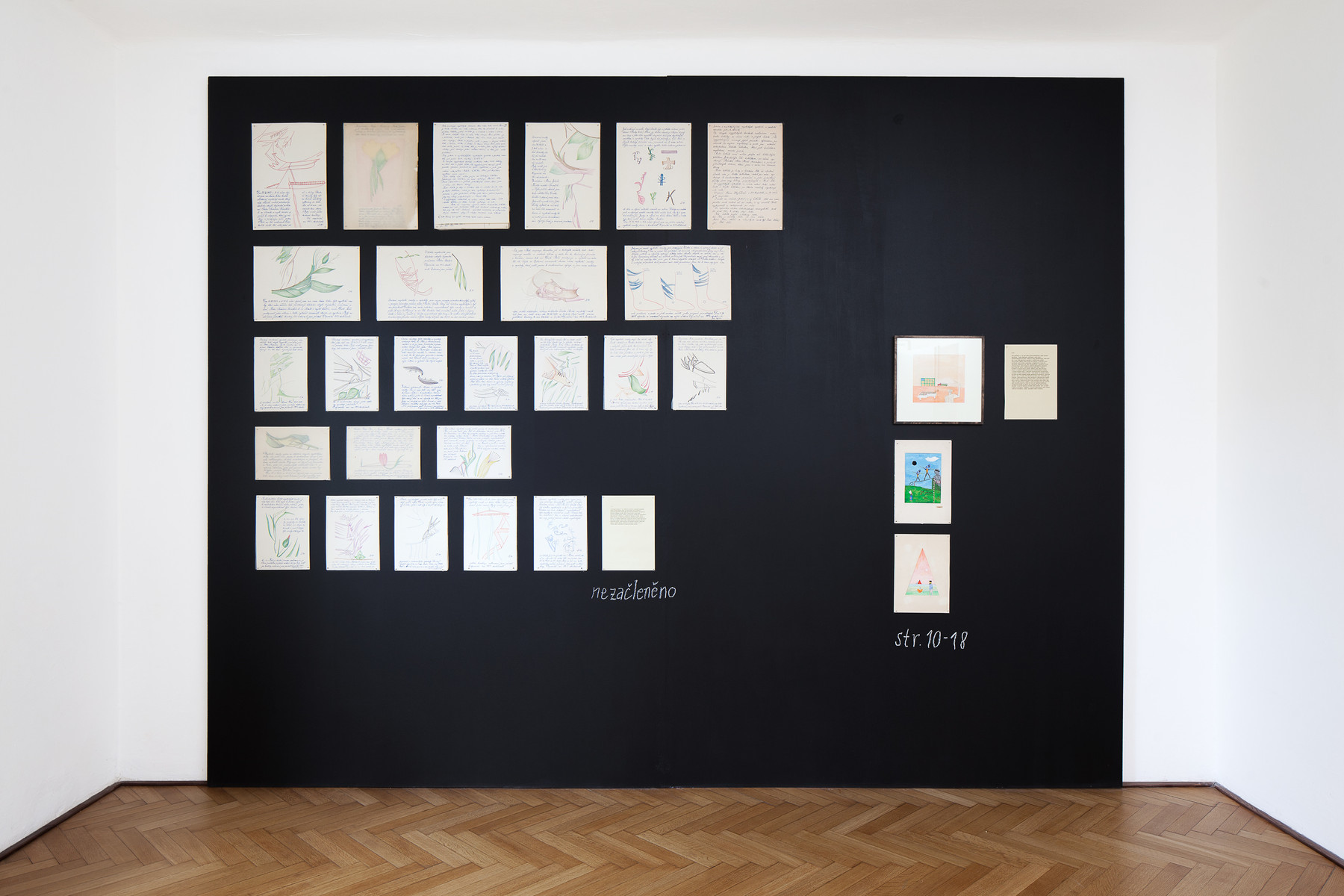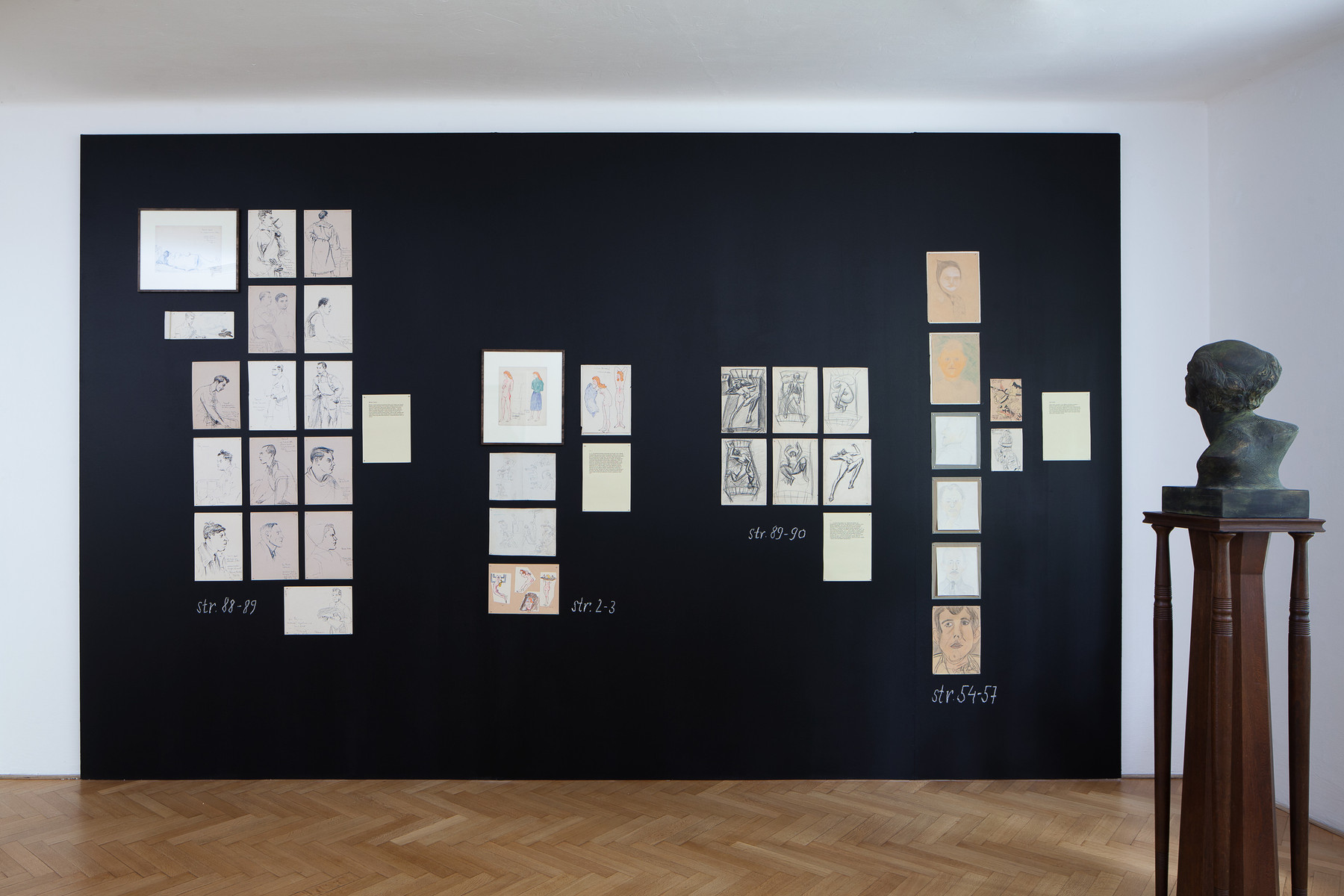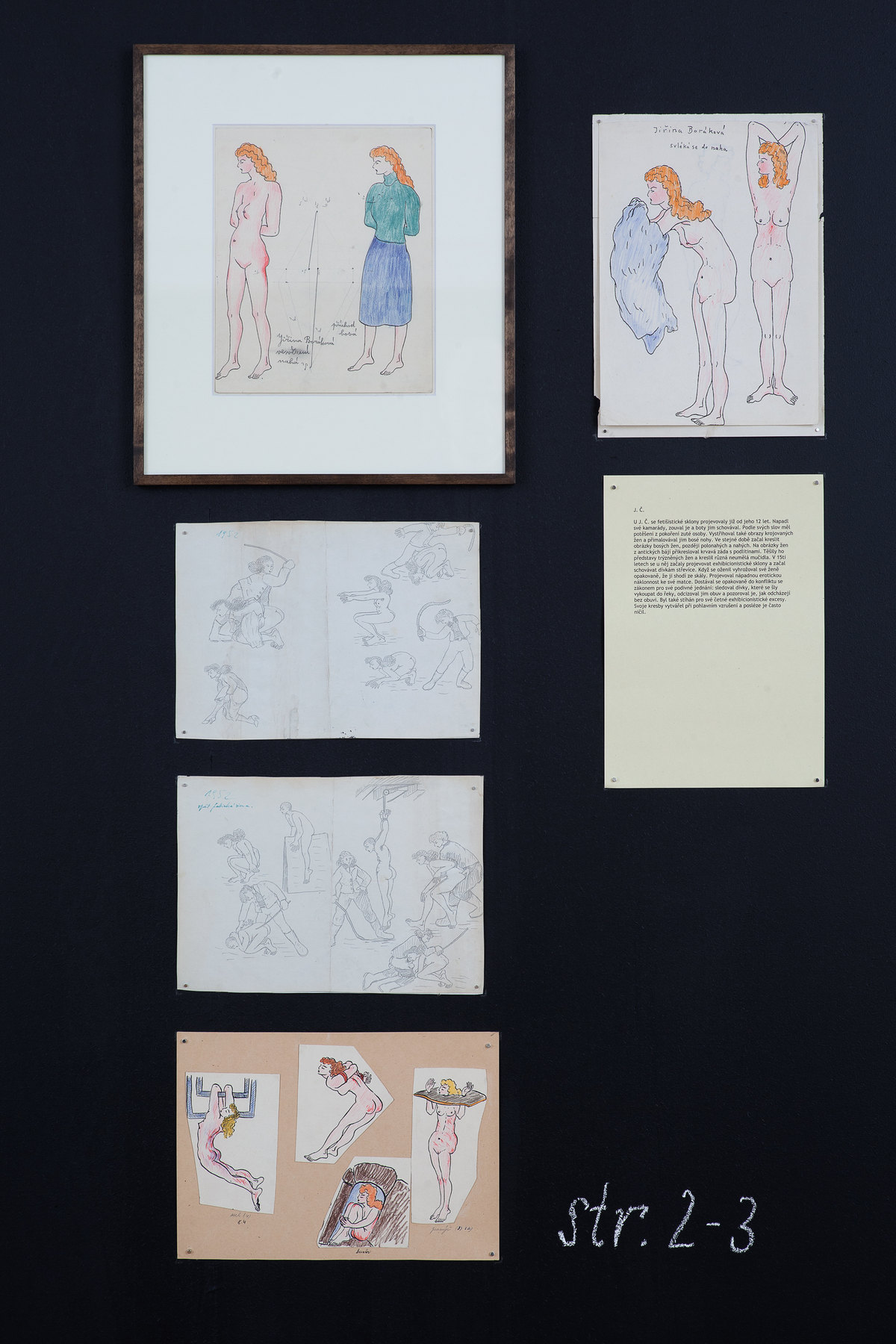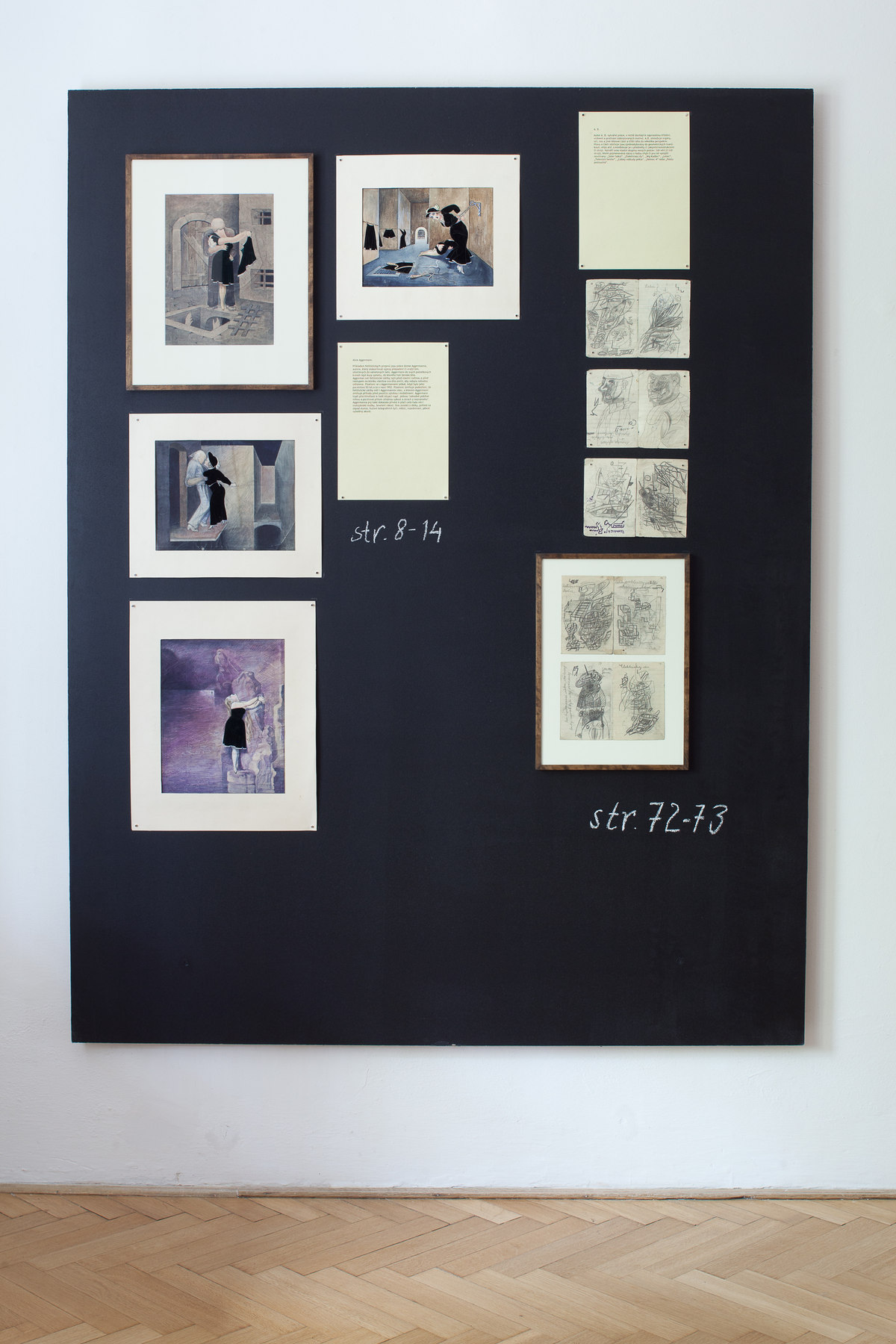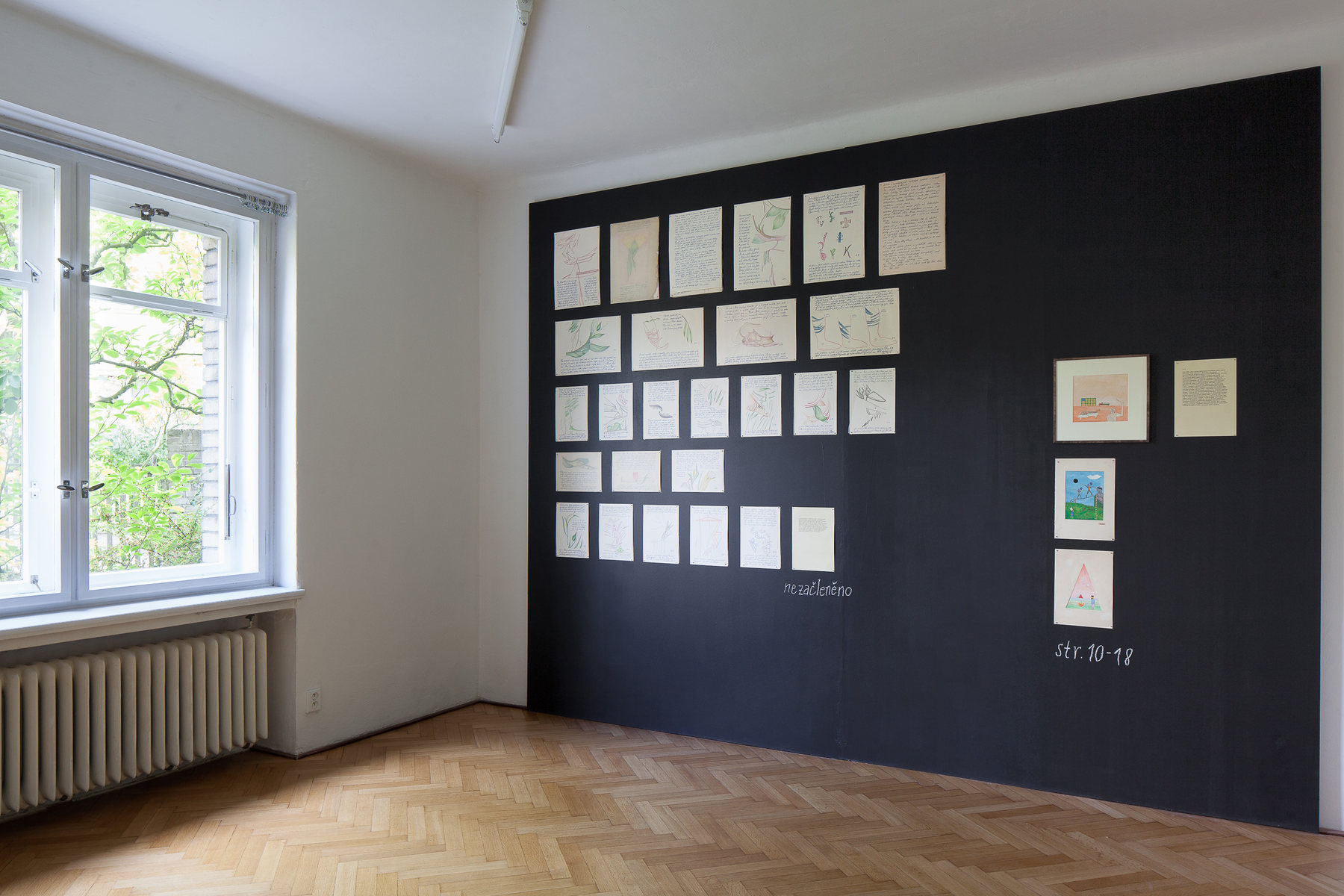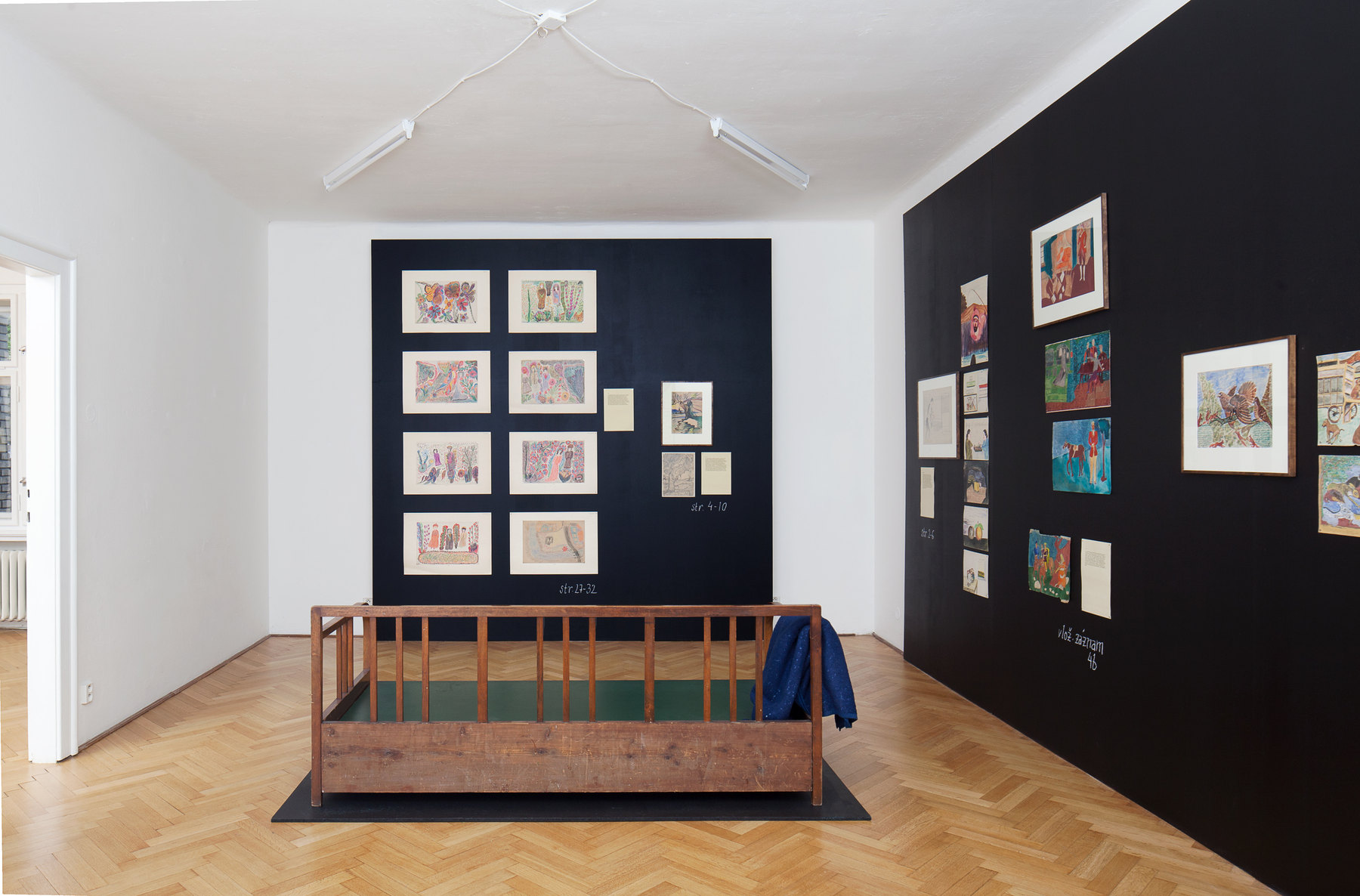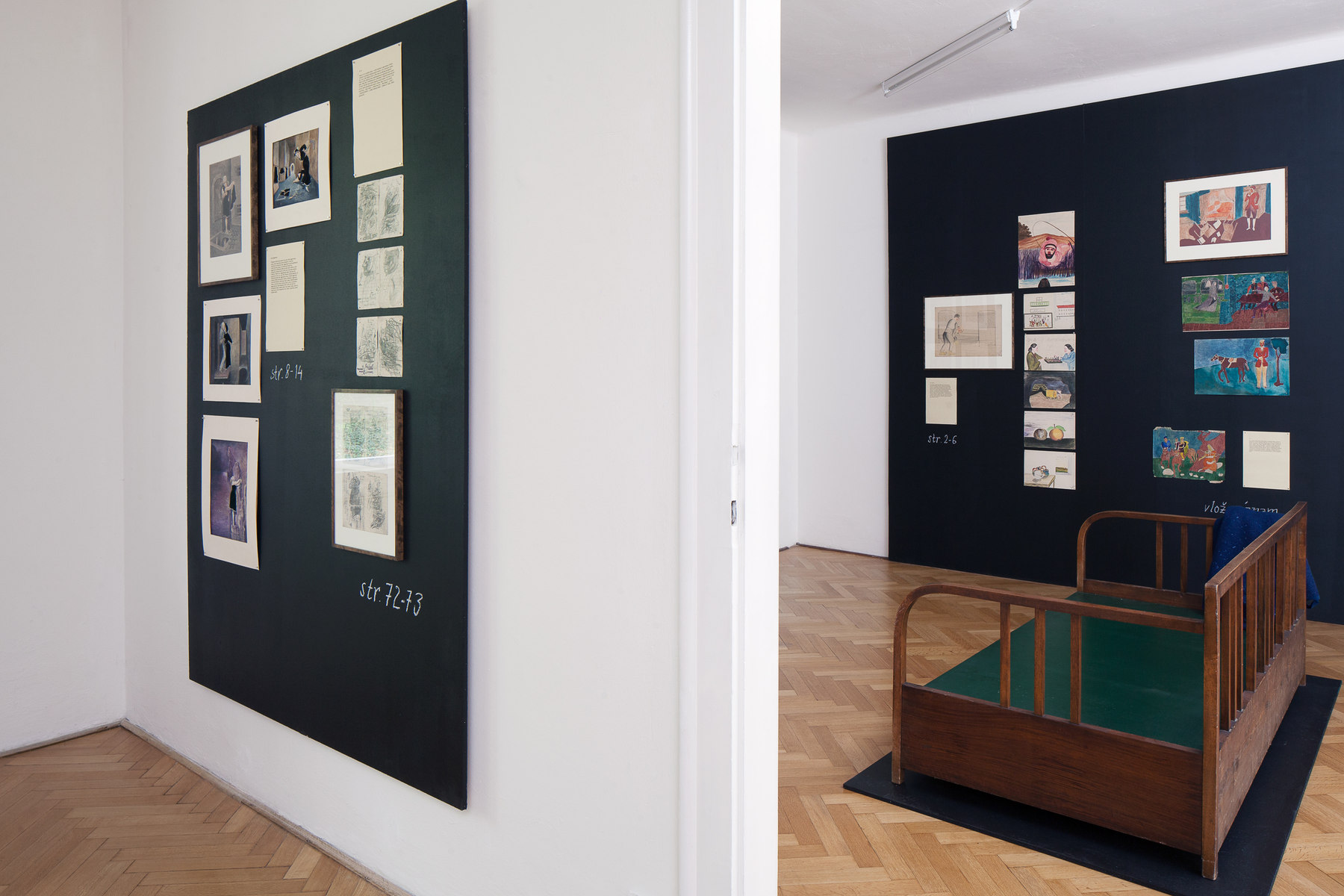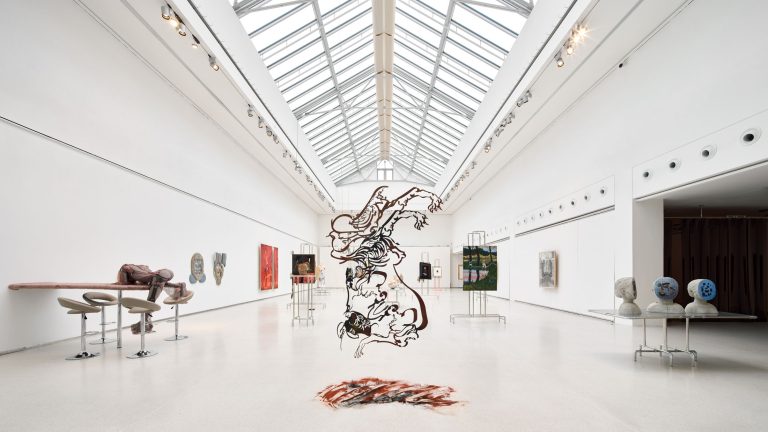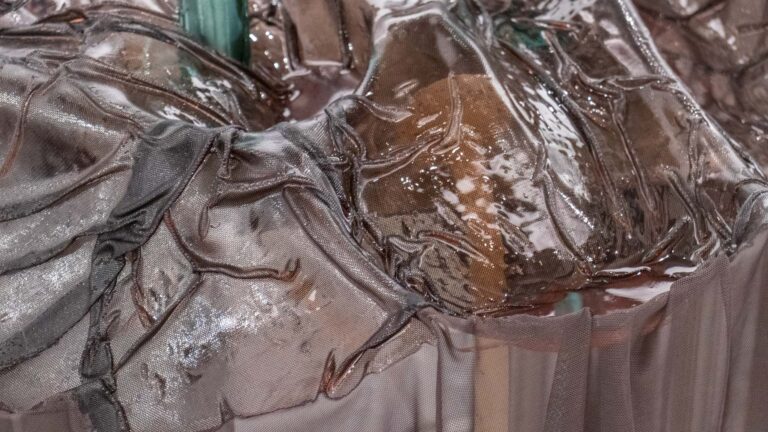Artist: Eva Koťátková
Exhibition title: Písařovic’s Workroom (composed by Eva Koťátková)
Venue: SVIT, Prague, Czech Republic
Date: September 23 – October 31, 2015
Photography: images copyright courtesy of the artist and SVIT, Prague
Písařovic’s biography
(compiled on the basis of the recollections of his daughter, Magdalena Písařovicová, and close friends – the psychiatrist Zdeňek Bašný and the sexologist Ivo Pondělíček)
František Písařovic was born in 1913 in Prague. He was the son of a general practitioner, Karel Písařovic, a modern art enthusiast and a collector, with whom he shared left-wing thinking (he was an ardent Trotskyite). He attended the secondary school in Slovenská Street and in 1933 began studying medicine at Charles University. During that period he founded Komsomol in the Prague district of Žižkov. Písařovic’s studies were violently interrupted by the Second World
War, during which he worked for a time in the Aritma plant in Vysočany and was imprisoned for anti-Fascist activities.
Písařovic’s close friend, the psychiatrist Zdeněk Bašný, also recalls a quarrel between Písařovic and some Germans on a tram, which the driver tried to conceal by driving past certain stops. Písařovic completed his medical studies after 1945 and became a doctor in the sanatorium in the South Bohemian town of Vráž.
In 1946 he married Libuše Skládaná, who bore him a daughter, Magdalena. Písařovic attempted to go into neurology in
Kateřinská Hospital, but in the end he was not employed there due to slander about him. In 1947 he entered the university in Prague, where he dedicated himself to clinical psychiatry. From then on he worked in the area of psychopathology of artistic expressions of clinic patients. He gave numerous papers in the Czech Medical Association of J. E. Purkyně, where he worked for nine years. In 1951 he was convicted in the Slánský Trial and spent three months in prison.
Following an incident in the Prague clinic, when he assaulted its director, he was transferred to the Dobřany psychiatric clinic, which, according to Bašný, became a refuge for a number of incompliant doctors. Písařovic became senior consultant there in 1955, a position he held until 1957. He opened the closed wards in Dobřany, published a journal on patients’ rights, arranged a programme for patients and scheduled discussions and evening sessions with them. He introduced work therapy and led his patients to creative work and gardening. He was an opponent of group therapy, advocating, on the contrary, intensive work with the individual.
It was also in Dobřany that Písařovic’s friendship with the psychiatrist Zdeněk Bašný, Lubomír Hanzlíček and Zbyněk
Havlíček began. Nevertheless, Písařovic was determined to return to Prague. He missed his home in Chorvatská Street, where he had previously lived his whole life. He therefore welcomed an opportunity to return to Prague, even though it was not to the kind of job he had anticipated. He took on the post of out-patient psychiatrist in the Regional Institute for
National Health (OÚNZ ) in the Prague 3 district of Jarov and later in Štěpánská Street in Prague 1. In the 1950s he was accidentally poisoned by town gas, resulting in a breakdown of his autonomic nervous system. Although he recovered from the condition, he lost his former vitality. In order to continue working, he led individual therapy at OÚNZ in Štěpánská
Street. He prepared audio-recordings of music and literature for patients. Písařovic’s own literary texts were read for the recordings by his close friend, the sexologist Ivo Pondělíček. His last job was as the librarian in Kateřinská Hospital. Písařovic was an advocate of shock therapy, for which he was criticised by many of his colleagues. He believed in its therapeutic effects and even tested it on himself. He used the method to treat even patients for whom other psychiatrists did not recommend it. Nevertheless, he was intensely dedicated to many of his patients, remained in contact with them even after their discharge and accompanied many of them home. He was a distinctive personality whose peers were divided into avid supporters and enemies. He advocated a strongly individualistic approach and fundamentally treated his patients individually. During the last four years of his life he battled with bowel cancer and was cared for at home by his daughter Magdalena. He died in 1982.
Písařovic’s book and collection
In 1965 Písařovic completed his lifetime opus, Psychopathologie malířského projevu (Psychopathology of Artistic Expression), in which he “concentrated his experiences of the study of the artistic expression of all pathological syndromes”. Despite the author’s attempts, the book was never published and remained in the form of a typed manuscript with photographic illustrations. Only one chapter was published in English by the International Colloquium of Psychopathology of Expression with the title Psychopathology of Painters’ Expression. Some of Písařovic’s colleagues in the field took the view that the work was too broad and covered too heterogeneous areas and recommended narrowing its scope. The book is divided into four chapters. In the second chapter, titled Psychopatologické syndromy ve výtvarné projekci (Psychopathological Syndromes in Artistic Projection), Písařovic separated the syndromes into the following categories: Schizophrenic Syndrome in Artistic Projection, Paraphrenic Syndrome, Maniomelancholic Syndrome, Paranoiac Syndrome, Psychoneurotic Syndrome, Psychopathic Syndrome, Epileptic Syndrome, Cerebropathy, Oligophrenic Syndrome and Toxicomania. He illustrated each of the categories using specific cases and examples of the patients’ artworks. In the third chapter, Písařovic promotes the role of the psychiatrist in assessing works of art: “Psychiatry, which should be the guardian of the mental health of mankind, must take an interest in the values of society’s artistic production. Modern psychiatry included in its psychotherapeutic methods the aesthetic qualities of artistic creation as massive stimuli of the will to live. For that reason, psychiatry has the right and obligation to assess the aesthetic and ethical value of creative trends of both the past and present. It can therefore criticize those artistic influences that due to their insufficient qualities of content or form have a negative effect on aesthetic nurturing and sensibilities, or can even directly psycho-traumatise them. Such pseudo-artistic artefacts can be a product of psychopathic personalities or entire decadent socio-political eras.”
Písařovic criticises Bohuslav Brouk’s 1937 book Patologie životní zdatnosti (Pathology of Fitness for Life), which he labels as delusional and laic. In it, Brouk denounces the persecution of new ideas and idiosyncratic creativity instigated by Max Nordau, whose book 1892 book Entartung (Degeneration) 1892 became an ideological tool of the Nazis. Písařovic, on the contrary, was determined “in the interest of mental hygiene to specify, assess and differentiate art and aesthetics from the ideas and creations of similar bugs.” In his view, the works of Picasso, Klee, Dalí, Bosche and Brueghel were akin to those of schizophrenics. He attacked Dada and Surrealism, calling them and a range of other modern trends as “mentally ill dregs that discredited themselves.”
An integral and fundamental part of Písařovic’s book consists of reproductions of the works of psychiatric patients, many of which he owned and formed into an abundant, idiosyncratic and carefully structured collection. He numbered and grouped the individual works according to medical diagnosis, thus creating impressive tableaux combining the works of different patients that are characterised by the typical features of the given mental disorder. The works originated in a number of psychiatric institutions: the psychiatric hospitals in Bohnice and Dobřany and the Prague Psychiatric Clinic.
Písařovic’s collection is based on a paradox: it is a collection of quality, sensitively selected works, which, however, the collector was interested in primarily from a diagnostic perspective and did not regard them as fully-fledged works of art. The creative work of psychiatric patients, like a whole range of works of modern art, were for him an expression of sickness.
Písařovic’s Study
The exhibition Písařovic’s Study presents a selection of the extensive collection of works by psychiatric patients of Dr. František Písařovic from the period of the 1940s – 70s in its state as found. The selection shows the work of a number of artists numbered in the space as pages in Písařovic’s book. It does not, however, state the details of the specific diagnoses of the individual artists, by which the works are arranged in the book. This gives them the greater independence that they undoubtedly deserve as the impressive works of inventive authors, although the method of presentation does not entirely free them from dependence on their collector and the relations that he created between the individual works. The exhibition thus balances between a presentation of works of art as such and as working material. The pieces are presented to the spectator on black panels, which may distantly evoke a Warburgian array of images (memory archives) or a school blackboard on which the study material is set out. While some of the works have been fully identified and the viewer will discover a lot of information about the artist, in other cases we know only the initials of the author. This supports the working feel of the presentation, which shows the collection as discovered material that is studied and added to in the exhibition.
The connecting thread between the selected works is depiction of the human body – whether the artist’s or another’s.
While Alois Aggermann’s pieces demonstrate a fetishist fondness for depicting the female body clothed in velvet, those of Josef Fajman show the body in its condition following the administration of medication, insulin therapy etc. Some of the works embark on journeys to other worlds, presenting figures and bodies in historical costumes and mythological scenes or as half human, half animal figures, others turn their attention to the immediate surroundings, showing the world of the clinic, patients, doctors and treatment methods. The collection contains several works by well-known artists, for example Vladimír Boudník, who began in the 1950s to become interested in the Rorschach Test and developed a range of theories about stains as triggers for unconscious notions and experiences, as well as an imaging principle.
Písařovic’s couch, in which all the works had been stored for years and probably due to which they were preserved, is used as one of the exhibits. Similarly to his armchair, lamp, coffee table, pipe, mug, cane, book and other personal items, the couch becomes an equivalent to drawings and other graphic records, providing we perceive such items as a base for an absent body, an image of the body in a state of absence or an impression left by the body. Písařovic is thus not only he through whom the works of art are perceived, but also one of the exhibited cases, one of the authors.
The exhibition was organised by the artist Eva Koťátková, who in her work has long been interested in the artistic expressions of mentally ill artists and their “framing” in an artistic context. Her Asylum installation at the 53rd Venice Biennale, her theatre performance The Picture Atlas of Antonín, a Boy who Cut the Library of the Clinic into Pieces, the installation Psychological Theatre, a joint exhibition with the Art Brut artist Josef Hofer, Frames and Frameworks, and especially recent realisations in Bohnice Psychiatric Hospital – the exhibition and series of tableaux The Two-Headed Biographer and the theatre performance The Judicial Murder of Jakob Mohr – were projects that sought various ways of relating to these works, which in many cases are, rather than conventional works of art, impressive visions, imaginings, records or pieces of evidence for which we should seek other, unconventional forms of presentation. The exhibition
Písařovic’s Study is a way of presenting to the public (at least in a fragmentary form) a valuable collection of works by psychiatric patients, as well as a way of showing to the spectator the interesting and complicated personality of the Czech psychiatrist František Písařovic.
The exhibition also includes an audio-recording of selected literary texts by František Písařovic read by his grandson,
Kajetán Písařovic, which the visitor can listen to while seated in Písařovic’s armchair.
Acknowledgements: Magdalena Písařovicová, Kajetán Písařovic, Zděněk Bašný, MUDr. Zdeněk Bašný,
Prof. PhDr. Ivo Pondělíček

